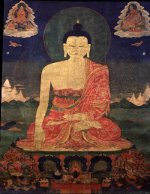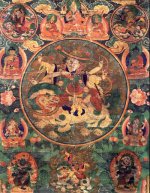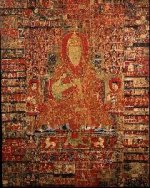
 Gyeltsab Darma Rinchen (rgyal tshab rje dar ma rin chen) was born in either 1362 or 1364, in a place called Rinang, in Nyangto, Tsang (gtsang myang stod ri nang). His father was a horse-master for a ruling family named Ba (rba); his mother was named Jomo Sherab (jo mo shes rab).
Gyeltsab Darma Rinchen (rgyal tshab rje dar ma rin chen) was born in either 1362 or 1364, in a place called Rinang, in Nyangto, Tsang (gtsang myang stod ri nang). His father was a horse-master for a ruling family named Ba (rba); his mother was named Jomo Sherab (jo mo shes rab).
At the age of ten he met Nenyingpa Rinchen Gyeltsen (gnas rnying pa rin chen rgyal mtshan, 14th c.) and lama named Draktokpa Zhonnu Tshultrim (brag thog pa gzhon nu tshul khrims, d.u.) and received novice vows. They gave him the name Darma Rinchen.
He studied epistemology with a lama named Kunga Pel (kun dga' dpal), and Prajñāpāramitā with Kabzhipa Rinchen Dorje (bka' bzhi pa rin chen rdo rje, 14th c.). A lama named Lodro Zangpo or Kabzhipa Losel (blo gros bzang po / dka' bzhi pa blo gsal) taught him the Vinaya. He also studied with Rendawa Zhonnu Lodro (red mda' ba gzhon nu blo gros, 1349-1412), a prominent Madhyamaka master of the Ngok tradition (rngog lugs), and is counted among Rendawa's seven close disciples.

 Darma Rinchen studied at Sakya Monastery (sa skya dgon), the Kadam monastery of Sangpu (gsang phu), and the Kagyu monastery Tsetang (rtse thang), which was later converted to the Geluk tradition. He is said to have engaged in philosophical debate with the Sakya masters Rongton Sheja Kunrig (rong ston shes bya kun rig, 1367-1449) and Khenchen Yagpa (mkhan chen g.yag pa), emerging victorious both times.
Darma Rinchen studied at Sakya Monastery (sa skya dgon), the Kadam monastery of Sangpu (gsang phu), and the Kagyu monastery Tsetang (rtse thang), which was later converted to the Geluk tradition. He is said to have engaged in philosophical debate with the Sakya masters Rongton Sheja Kunrig (rong ston shes bya kun rig, 1367-1449) and Khenchen Yagpa (mkhan chen g.yag pa), emerging victorious both times.
At the age of twenty-five he took ordination in Lato with Doklo Choje Kunga Pel (ldog lho pa chos rje kun dga' dpal), Rendawa, Je Gangchen Kunga Pelwa (rje gangs can kun dga' dpal ba), Pelden Lodro (dpal ldan blo gros), and Lodro Tsungme (blo gros mtshungs med).
Going to U to study in monasteries there, at Nyelto Radrong (gnyal stod ra grong) he encountered Tsongkhapa Lobzang Drakpa (tsong kha pa blo bzang grags pa, 1357-1419), the brilliant scholar monk from Amdo who was then establishing his teaching base in the Lhasa area. He became one of Tsongkhapa's main disciples, and is generally depicted sitting to the left of the master.
Darma Rinchen was instrumental in the establishment of Ganden Namgyel Ling (dga' ldan rnam rgyal gling) in 1409. He assisted in ordaining monks and establishing the ritual calendar.

 Following Tsongkhapa's death in 1419, at the age of fifty-four or fifty-six Darma Rinchen ascended to the golden throne of Ganden, becoming the Second Ganden Tripa (dga' ldan khri pa), the official head of the Geluk tradition. It was at that time that he acquired the title Gyeltsab (rgyal tshab), the "regent" of Tsongkhapa.
Following Tsongkhapa's death in 1419, at the age of fifty-four or fifty-six Darma Rinchen ascended to the golden throne of Ganden, becoming the Second Ganden Tripa (dga' ldan khri pa), the official head of the Geluk tradition. It was at that time that he acquired the title Gyeltsab (rgyal tshab), the "regent" of Tsongkhapa.
He held the abbacy for eleven years, occupying his time in exposition, debate, and composition ('chad rtsod rtsom gsum). In 1431, the year before he passed away, he passed the abbot's throne to one of Tsongkhapa's other disciples, Khedrub Gelek Pelzang (mkhas grub dge legs dpal bzang, 1385-1438), who thus became the Third Ganden Tripa.

 Gyeltsab was a prolific author, composing works on Madhyamaka, Epistemology, and the Guhyasamāja, among other topics. Among his best known works are his commentary on the Bodhisattvacaryāvatāra (spyod 'jug rtsa 'grel). His collected works are in eight volumes.
Gyeltsab was a prolific author, composing works on Madhyamaka, Epistemology, and the Guhyasamāja, among other topics. Among his best known works are his commentary on the Bodhisattvacaryāvatāra (spyod 'jug rtsa 'grel). His collected works are in eight volumes.
He passed away at the age of sixty-seven or sixty-nine, in 1432, on the eighth day of the fifth month of the male water-mouse year, on the Potala hill in Lhasa.
Images

Shakyamuni Buddha
The central figure of Shakyamuni Buddha is shown with Tsongkhapa and primary disciples in the upper left corner. Below are protector deities.

Tsongkhapa
A painting of Tsongkapa, founder of the Geluk tradition, with the two principal students, Gyaltsab on the left and Khedrub on the right.
Bibliography
Grags pa 'byung gnas. 1992. Gangs can mkhas grub rim byon ming mdzod. Lanzhou: Kan su'u mi rigs dpe skrun khang, pp. 407-408
Sde srid sangs rgyas rgya mtsho. 1989 (1698). Dga' ldan chos 'byung baiDU r+ya ser po. Beijing: Krung go bod kyi shes rig dpe skrun khang, pp.73-75.
Tshe mchog gling yongs 'dzin ye shes rgyal mtshan. 1970 (1787). Byang chub lam gyi rim pa'i bla ma brgyud pa'i rnam par thar pa rgyal mtshan mdzes pa'i rgyan mchog phul byung nor bu'i phreng ba. New Delhi: Ngawang Gelek Demo. Volume 1, pp. 814-822.
Ye shes rgyal mtshan. 1990. Sras kyi thu bo rgyal tshab dar ma rin chen gyi rnam thar. In Lam rim bla ma brgyud pa'i rnam thar, pp. 386-394. Lhasa: Bod ljongs mi dmangs dpe skrun khang.


